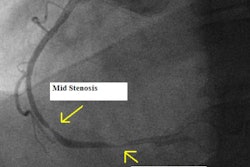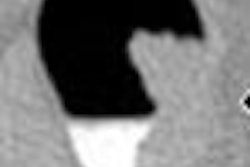Bone scintigraphy with SPECT has a good track record for detecting metastatic areas with a high lesion-to-background contrast. But a drawback of SPECT, compared to molecular imaging modalities such as PET/CT, has been that anatomic details can be lacking.
Still, in recent years the introduction of hybrid cameras that combine SPECT with spiral CT has enabled the correlation of functional information from SPECT scintigraphic studies with morphology, noted Dr. Wolfgang Romer, from the Clinic of Nuclear Medicine at the Erlangen University Hospital in Erlangen, Germany.
"SPECT/CT offers the opportunity to perform a diagnostically sufficient CT of scintigraphically suspicious lesions directly consecutive to SPECT in the same session," he said at the 2005 RSNA meeting in Chicago.
Romer presented the results of a study conducted at his institution that defined the value of SPECT/CT in the evaluation of unclear foci of increased bone metabolism in cancer patients.
The researchers conducted their studies on a Symbia T2 system (Siemens Medical Solutions, Malvern, PA), which combines a dual-detector variable-angle gamma camera with a dual-slice spiral CT scanner. A total of 44 cancer patients, 10 men and 34 women with a mean age of 66 years, underwent planar whole-body scintigraphy conducted three hours postinjection of Tc-99m-dicarboxypropane diphosphonate. In the case of unclear findings, SPECT/CT was performed, Romer said.
The team sought to keep the radiation burden on its patients as low as reasonably possible with its SPECT/CT protocol, Romer noted. To achieve this goal, a SPECT scan was performed with a field-of-view centered on the unclear foci. The researchers then limited the field-of-view of the CT portion of the scan to the region where unclear foci were detectable on SPECT.
In addition, because only bony structures were to be analyzed, the tube current was limited to 100 mAs. CT slice collimation was set at 2 mm x 2.5 mm, and image reconstruction resulted in 3-mm images, he reported. With the use of the CT data, the group was able to reconstruct attenuation-corrected SPECT images. Both the SPECT and CT scans were conducted consecutively in one imaging session, sparing the patients an additional diagnostic procedure, Romer said.
The SPECT images were retrospectively analyzed by two physicians experienced in both nuclear medicine and radiology, and who were blinded to the clinical data. The reviewers rated lesions on a scale of 1-3 (1 = not malignant, 2 = indeterminate, and 3 = malignant); they were then presented with SPECT/CT images of the indeterminate findings utilizing the same rating scale.
"In total, 52 lesions of enhanced tracer uptake were judged as indeterminate on the SPECT images and were further evaluated by SPECT/CT," Romer said.
Out of these, 33 (64%) were clearly correlated with the findings in CT, mostly osteochondrosis and spondylosis, according to Romer. In 15 (29%) of the lesions, malignant findings could be correlated with CT. In the remaining four lesions (8%), neither clear malignant nor clear degenerative processes were found, even after analysis with the SPECT/CT. For these patients, further evaluation with MRI was necessary.
Romer said that the research team's preliminary results indicate that the use of SPECT/CT results in a considerable gain in specificity.
"SPECT/CT was able to clarify more than 90% of the findings that had been originally classified as indeterminate on SPECT of the exoskeleton," he said.
By Jonathan S. Batchelor
AuntMinnie.com staff writer
February 9, 2006
Related Reading
A new use for SPECT/CT: Tracking stem cell migration, October 7, 2005
SPECT/CT pilots prostate brachytherapy in community setting, August 15, 2005
Can SPECT/CT revitalize nuclear medicine? July 7, 2005
SPECT/CT developing role in coronary artery disease assessment, March 22, 2005
SPECT/CT improves bladder cancer staging, management, May 12, 2004
Copyright © 2006 AuntMinnie.com



















